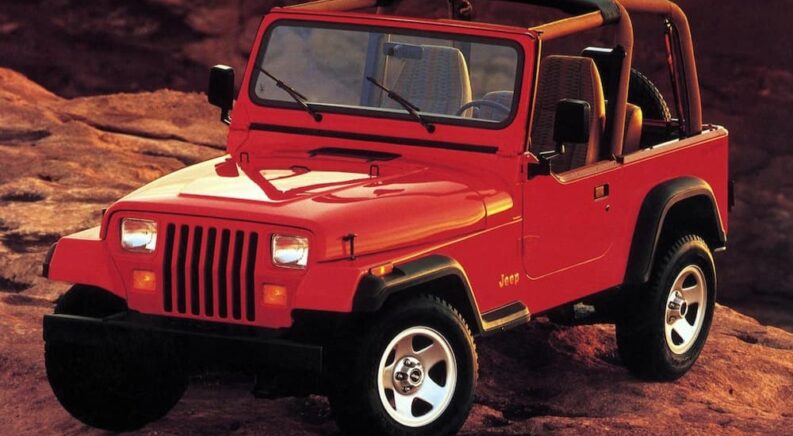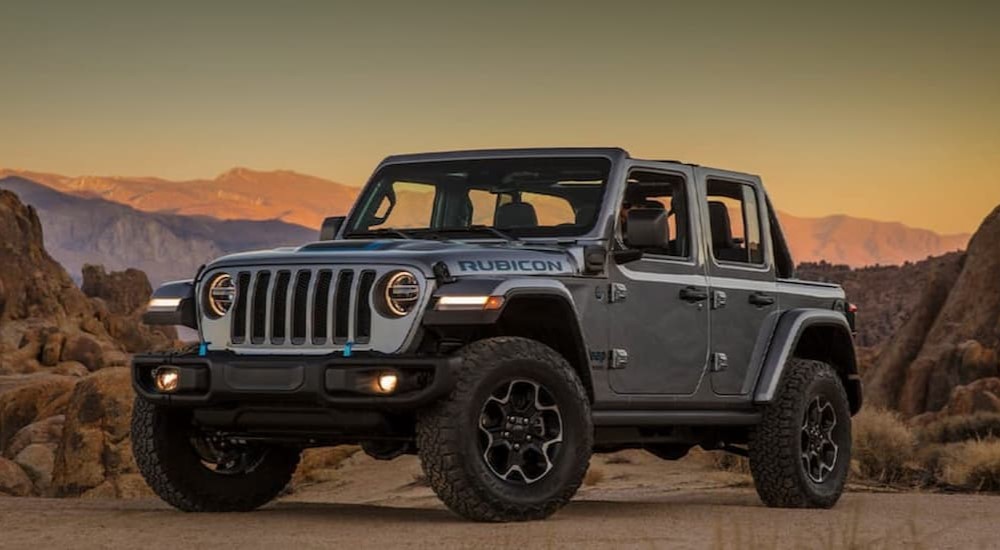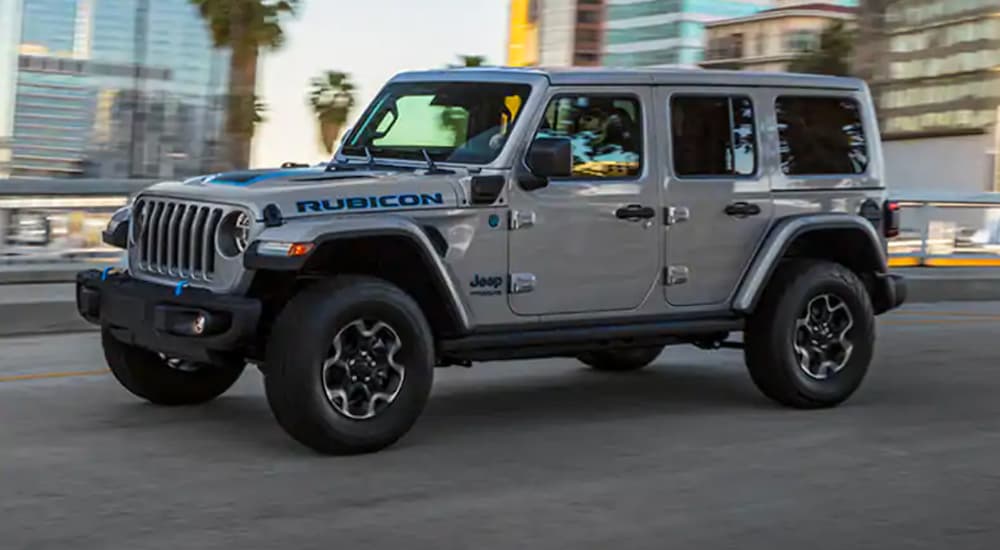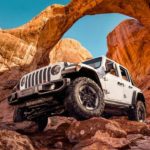When you come across a dealership offering a used Jeep Wrangler for sale, you never quite know what you’re going to get. The nameplate “Wrangler” isn’t a part of WWII history like the brand name Jeep was, although it has been around for several decades now and has been through a few generations of change. As with all vehicles, it has had its ups and downs as it has evolved and adjusted to changing tastes and driver preferences.
Today we’re going to take a look at some of the best and worst eras in the Wrangler’s history. Whether you’re looking to get a used Wrangler or are a Jeep enthusiast interested in the brand’s history, you’re sure to enjoy this ride down memory lane.
Worst: YJ Wrangler
After years of producing the popular CJ series, Jeep replaced it with the very first generation of the Wrangler. The “YJ” era is nostalgic for Jeep fans for a few reasons. For one, it has unique design elements like square headlights that hadn’t appeared before and haven’t returned since. Anything different is bound to stand out and have its share of fans who prefer it.
However, keep in mind that when Jeep re-designed the Wrangler for its second generation, almost 80% of the vehicle’s parts were upgraded. You don’t change your flagship model that much if there’s nothing that needs fixing. One particular thing this generation lacks is coil springs, so don’t expect a smooth ride. Plus, even the newest models in this generation are almost 20 years old by this point. Jeeps may be built tough, but this quality can only take you so far, especially if you’re roughing it off-road often enough.
Best: TJ Wrangler
The TJ generation of the Wrangler kept the retro look giving it a visual link to Jeeps dating all the way back to World War II—but under the surface, it had plenty of innovations making it more capable and comfortable. Leaf springs were replaced with a Quadra-Coil suspension system, meaning that there were coil springs on all four wheels, giving it a much smoother ride on the rough off-road surfaces it was designed to tackle. Axle articulation was also enhanced, and more ground clearance was added for better angles of approach and departure on steep grades and uneven surfaces.
Worst: 2007 Wrangler
The change from TJ to JK was absolutely a necessary one, but it wasn’t without its growing pains. For the 2007 model year, Jeep worked to keep the Wrangler’s charm and appeal to drivers looking for a no-frills off-road option while making the model work for a wider range of drivers. This meant making the Wrangler drive better on paved roads, as opposed to having less on-road comfort as a reasonable sacrifice for ultimate off-road maneuverability.
The JK generation undoubtedly offers a smoother ride. It provided the first four-door option, and the 2007 model offers a safety advantage over the 2006 Wrangler regarding frontal crashes, according to the National Highway Traffic Safety Administration. But NHTSA also reports that the 2007 model does have a high number of recalls and complaints. The powertrain and interior of the JK Wrangler were improved in later model years, so the 2007 Wrangler was simply a bump in the road—not a sign of decline for the iconic vehicle.
Best: Wrangler Rubicon
The Wrangler Rubicon, named after a famous trail in the Sierra Nevada mountain range, was first introduced in 2003. It instantly made a name for itself by including a laundry list of rugged features that took the Wrangler’s already legendary off-road capability to the next level. Right out of the gate, the original Rubicon features a Rock-Track 4×4 system with Goodyear off-road tires providing plenty of grip, four-wheel disc brakes, diamond-plate rock rails for crawling over boulders, Dana 44 axles, and air-actuated Tru-Lok front and rear lockers for getting out of sticky situations in the unpredictable wilderness.
The Rubicon’s introduction was followed shortly by the debut of the Wrangler Unlimited, a model with a longer wheelbase providing more room for cargo. In 2005, these two innovations were combined in the Rubicon Unlimited, featuring both a large wheelbase and a comprehensive lineup of off-road features. Whether in a standard Wrangler or an Unlimited model, the Rubicon has continued to be a popular version through the years that followed and has been improved upon during the generations since its original release. Just about any Rubicon model is sure to stand up to even the toughest OHV trails.
In 2021, the Rubicon was taken to yet further extremes with the Wrangler Rubicon 392. From the most recent JL generation, this option is powered by a 6.4L V8 engine that provides up to 470 hp and 470 lb-ft of torque, helping it accelerate across sand dunes and crawl over mountains. Its sway bar can be disconnected electronically, letting you switch between stability on flat surfaces and maximum articulation on uneven terrain. While the lush interior would certainly feel out of place on a YJ Wrangler, classic Jeep features like a spare tire on the back and available half-doors keep the brand’s aesthetic alive.
Worst: 2012 Wrangler
Like the 2007 Wrangler, the 2012 model is plagued by a higher-than-average number of recalls. According to NHTSA, the 2012 model has had ten recalls, while the 2013 model brought that number down to seven, and the 2014 Wrangler has a mere four. Equipped with a new powertrain under the hood as part of a mid-generation refresh, we can again chalk this up to growing pains that the Wrangler has ultimately managed to overcome. While the 2012 model has been named the worst model year for the Wrangler multiple times, the Wrangler’s popularity overall has continued to grow among adventurous drivers.
Best: Wrangler 4xe
Electrification isn’t just for tiny commuter cars anymore. From performance cars to pickup trucks, all kinds of vehicles have been getting electrified lately, including the Wrangler. The hybrid 4xe model debuted in 2021, featuring a battery pack that not only provides the powertrain with a little extra juice but is also fully sealed against water so it can withstand the conditions a Jeep needs to be able to handle to earn the coveted “Trail Rated” badge. The Wrangler 4xe’s electric-only driving range is nice and quiet, which can come in handy when leaving a campsite early in the morning or when trying to get within camera range of wildlife without scaring your subjects away.
Along with the release of the 4xe, Jeep announced a plan to build solar-powered charging stations at remote trailheads across the country. Once these stations are built, it would pave the way for electric off-road vehicles to become a more viable option. While the 4xe is still mainly powered by fossil fuels, it’s an important first step for the electrification of off-road vehicles.
Final Thoughts
The Wrangler’s status as an iconic vehicle has been both a blessing and a challenge for Jeep over the years. Engineers at the automaker have had to keep the vehicle relevant as the decades brought new technologies and tastes while still maintaining the Wrangler’s essential essence. Change it too much and you anger the fans; change it too little and it gets left behind. Looking back on the ups and downs of the Wrangler’s past, it seems like Jeep has largely managed to walk this line well.
The modern Wrangler is every bit as rough and ready for action as its predecessors, but improvements like a more comfortable interior and options that offer more cargo space or more doors are a welcome addition. Electrification is an exciting new aspect that has the potential to change the game even more. We’ll be interested to see how the brand continues to grow and change over the decades to come.





